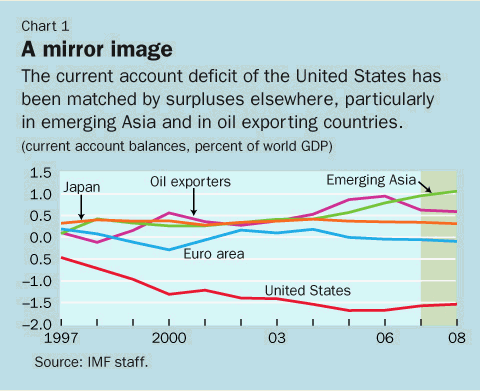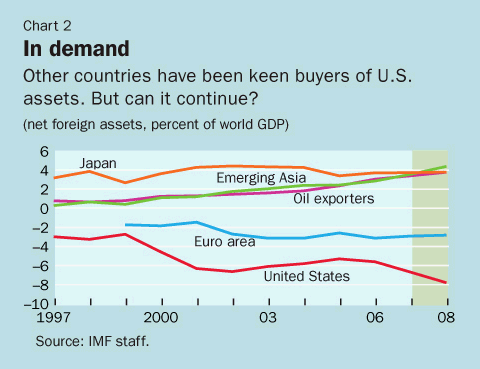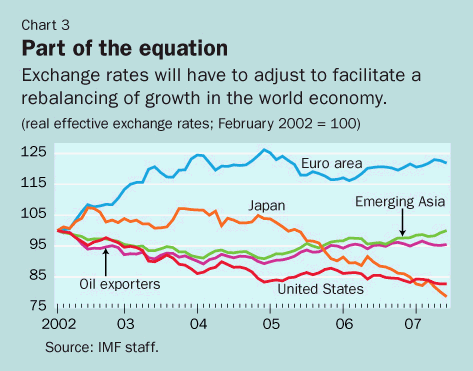
Typical street scene in Santa Ana, El Salvador. (Photo: iStock)
IMF Survey: IMF Offers Compromise Path on Imbalances
August 7, 2007
- Economists differ on whether global imbalances really pose a threat to world growth
- Views on when and how any adjustment will take place vary widely
- IMF strategy offers win-win path to orderly adjustment
The debate on the causes and consequences of global imbalances—the large current account deficit in the United States and surpluses elsewhere—has taken center stage in both policy and academic circles for quite some time.

New refinery at Haradh, Saudi Arabia: IMF urges oil-producing countries to tackle imbalances by boosting spending in line with absorptive capacity (photo: AFP)
MULTILATERAL CONSULTATION
While most economists agree that the imbalances (see Chart 1) have a variety of causes, their relative importance and the associated risks remain subject to much dispute.

For example, some analysts point to low public and private savings in the United States and warn of the risks of a sharp and potentially disruptive correction in exchange rates (Obstfeld and Rogoff, 2005; Krugman, 2007). Others stress a "savings glut" in the rest of the world (Bernanke, 2005) or the attractiveness of U.S. financial assets for foreign investors (Caballero and others, 2006). For them, imbalances look more sustainable and thus pose fewer risks to the global economy.
From a policy perspective, it is important to distinguish clearly between what we know and what we do not know. On the one hand, almost all would agree that
• Imbalances will eventually adjust. As matter of arithmetic, the U.S. primary current account deficit (current account excluding net investment income), now running at more than 6 percent of GDP, will need to fall sharply to stabilize the U.S. net external position.
• The adjustment will involve a substantial reduction in U.S. domestic demand relative to output. Since the U.S. is a large economy, this could have significant implications for growth in the rest of the world.
On the other hand, we are much less certain
• When this adjustment will take place. Foreign demand for U.S. assets must eventually stabilize, but we have no good understanding of when, particularly with rapid financial globalization (see Chart 2).
• Whether the eventual adjustment will be abrupt or orderly. From a historical perspective, a gradual adjustment may be the most likely outcome (although there are few comparable episodes), but the risk of a more abrupt change in investor sentiment cannot be ruled out.

How should policymakers react in the face of such uncertainties? The IMF's policy recommendations to address imbalances (the so-called IMFC Strategy) focus on a number of elements:
• The United States must take steps to boost national saving, including fiscal consolidation;
• Europe and Japan must make further progress on growth-enhancing reforms, thereby boosting domestic demand;
• Emerging Asian economies should seek to boost domestic demand and allow greater exchange rate flexibility in a number of surplus countries; and
• Oil-producing countries should seek to increase spending consistent with absorptive capacity and macroeconomic stability.
Each of these policies is in the best medium-term interests of the country concerned. However, taken together, the policies will also facilitate a rebalancing of global demand and corresponding adjustments in exchange rates (see Chart 3) while maintaining robust global growth. As such, they constitute an important form of policy insurance to reduce the risks stemming from global imbalances.

Over the past year, some progress has been achieved in implementing the IMFC Strategy. But with imbalances still close to historic highs, much remains to be done. The policy intentions set out by the participants in the multilateral consultation are an important step in the right direction, and the current benign global environment offers a welcome opportunity to make progress in implementing them.
The author is a member of the IMF's multilateral consultation team.
Further reading:
Bernanke, Ben, 2005, "The Global Savings Glut and the U.S. Current Account Deficit," Sandridge Lecture, Virginia Association of Economics (Federal Reserve Board).
Caballero, Ricardo, Emmanuel Farhi, and Pierre-Olivier Gourinchas, 2006, "An Equilibrium Model of `Global Imbalances' and Low Interest Rates," NBER Working Paper 11196 (Cambridge, Massachusetts: National Bureau of Economic Research).
Krugman, Paul, 2007, "Will There Be a Dollar Crisis?" Economic Policy, forthcoming.
Obstfeld, Maurice, and Kenneth Rogoff, 2005, "Global Current Account Imbalances and Exchange Rate Adjustments," Brookings Papers on Economic Activity:1, pp. 67-146.
Obstfeld, Maurice, and Kenneth Rogoff, 2007, "The Unsustainable U.S. Current Account Position Revisited," in G7 Current Account Imbalances: Sustainability and Adjustment, edited by Richard Clarida (Chicago: Chicago University Press for NBER).


